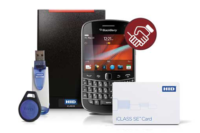“It’s a learning curve right now,” says Steve Dentinger, director of marketing, Keyscan, Whitby, Ontario, Canada. “A lot of consumers are just now learning about [smart cards]. With the emergence of FIPS 201 and HSPD-12, there is a lot of talk about secure technology, and that technology is on a smart card base.”
All of the interest in smart cards doesn’t mean that proximity, or 125 KHz cards are going away any time soon, however. “I think smart cards are still somewhat at an early adopters’ stage,” says Andy Bulkley, product manager, access hardware, GE Security, Bradenton, Fla. “They are just beginning to move up the product adoption curve to the early majority stage.”
Card Trends
For many applications, proximity is no longer enough, however. In an increasingly technologically complex world, customers want more. “I think there are significant numbers of 125 KHz cards and readers deployed and there will always be a need to support that,” Dentinger says. “But as consumers become more aware of newer, more secure technologies such as 13.56 MHz smart cards with built-in encryption, we will start to see more migration to more secure cards.”
Led by the government standards and adoption, smart card technology has much to offer, particularly in campus environments that want multi-use cards.
Reader Trends
“One of the things we see in our sales numbers is a continuous shift of purchases towards migration readers — readers that accept more than one technology such as proximity with smart card, for example,” Jarvis says.
Putting Everything Together
“The integrator in the past didn’t have to worry about a proximity reader’s security level and requirements to protect the data on the card,” says Cal Yacoub, technology leader with ISP Access Hardware Development, GE Security. “But when you move to a secure sector smart card/reader, now you have to worry about the data, the level of encryption and the level of protection. The integrator has to understand the differences and what the product offerings are.”
Considering Biometrics
Any talk of smart cards often brings up the subject of biometrics as well. For dealers and integrators wanting to sell the smart card benefit to an end user, this is a future-proofing discussion that should occur.“A lot of companies overlook biometrics,” says Beth Thomas, product marketing manager, Honeywell. “There are some open standards for fingerprints, but even the way an open standard template is put on a card could vary a little bit. When you encode data on a smart card, if you don’t have the knowledge to know what goes where, it could cause you problems later on when you choose a biometric reader.”
If biometrics is something a customer might want in the future, one option is to choose a product that already marries to a specific biometric.
Keyscan has recently partnered with a fingerprint biometric manufacturer, for example. “We have done some unique integration with our Smart Gate reader,” says Steve Dentinger, director of marketing for Keyscan.
But, he adds, adding any biometric onto a smart card should be doable as long as you have the right kind of space on the card. “As long as you have a continuous block of data that a biometric template can be stored on, it can be done.”
However it’s achieved, the goal is a smooth and easy process for the end user.
“When you add biometrics to the system, you want the capturing and encoding on the card to be a seamless process for that customer,” says Andy Bulkley, product manager, access hardware, GE Security.

